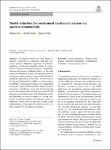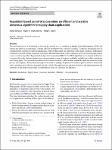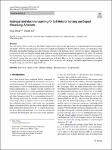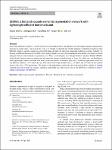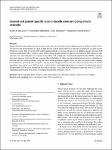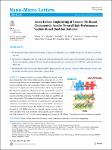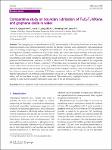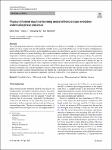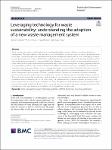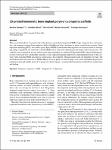Search
Author
- Osman, Ahmed I. (5)
- Daqing, Ma (3)
- Jorgensen, Ed (3)
- Li, Yan (3)
- next >
Subject
- kinh tế (26)
- Economics (12)
- programming (10)
- XRD (10)
- next >
Date issued
- 2020 - 2025 (2128)
- 2010 - 2019 (129)
- 2000 - 2009 (9)
- 1999 - 1999 (1)
Has File(s)
Search Results
Dynamical systems are often subject to algebraic constraints in conjunction with their governing ordinary differential equations. In particular, multibody systems are commonly subject to configuration constraints that define kinematic compatibility between the motion of different bodies. A full-scale numerical simulation of such constrained problems is challenging, making reduced-order models (ROMs) of paramount importance. In this work, we show how to use spectral submanifolds (SSMs) to construct rigorous ROMs for mechanical systems with configuration constraints. These SSM-based ROMs enable the direct extraction of backbone curves and forced response curves and facilitate efficient bifurcation analysis. We demonstrate the effectiveness of this SSM-based reduction procedure on seve... |
The growing interest in blockchain technology has gained a lot of attention in Supply Chain Management (SCM) and sparked the quest for decentralized, scalable, efficient and trustworthy consensus schemes. Traditional blockchains rely on computationally expensive consensus mechanisms with low throughput and high latency. This paper conducts a performance evaluation of several existing consensus protocols to illustrate blockchain’s shortcomings in terms of consensus and propose a new consensus algorithm: Reputation based proof of cooperation (RPoC). The RPoC algorithm uses a layered architecture to segment the nodes that participate in the consensus phase in order to improve scalability and efficiency while maintaining trust among peers. |
The soft robotics field is on the rise. The highly adaptive robots provide the opportunity to bridge the gap between machines and people. However, their elastomeric nature poses significant challenges to the perception, control, and signal processing. Hydrogels and machine learning provide promising solutions to the problems above. This review aims to summarize this recent trend by first assessing the current hydrogel-based sensing and actuation methods applied to soft robots. We outlined the mechanisms of perception in response to various external stimuli. Next, recent achievements of machine learning for soft robots’ sensing data processing and optimization are evaluated. Here we list the strategies for implementing machine learning models from the perspective of applications. Las... |
EBUNet: a fast and accurate semantic segmentation network with lightweight efficient bottleneck unit It has been difficult to achieve a suitable balance between effectiveness and efficiency in lightweight semantic segmentation networks in recent years. The goal of this work is to present an efficient and reliable semantic segmentation method called EBUNet, which is aimed at achieving a favorable trade-off between inference speed and prediction accuracy. Initially, we develop an Efficient Bottleneck Unit (EBU) that employs depth-wise convolution and depth-wise dilated convolution to obtain adequate features with moderate computation costs. Then, we developed a novel Image Partition Attention Module (IPAM), which divides feature maps into subregions and generates attention weights based on them. As a third step, we developed a novel lightweight attention decoder with which to retriev... |
Seizure prediction algorithms have been central in the field of data analysis for the improvement of epileptic patients’ lives. The most recent advancements of which include the use of deep neural networks to present an optimized, accurate seizure prediction system. This work puts forth deep learning methods to automate the process of epileptic seizure detection with electroencephalogram (EEG) signals as input; both a patient-specific and general approach are followed. EEG signals are time structure series motivating the use of sequence algorithms such as temporal convolutional neural networks (TCNNs), and long short-term memory networks. We then compare this methodology to other prior pre-implemented structures, including our previous work for seizure prediction using machine learn... |
Sodium-based dual-ion batteries (SDIBs) have gained tremendous attention due to their virtues of high operating voltage and low cost, yet it remains a tough challenge for the development of ideal anode material of SDIBs featuring with high kinetics and long durability. Herein, we report the design and fabrication of N-doped carbon film-modified niobium sulfur–selenium (NbSSe/NC) nanosheets architecture, which holds favorable merits for Na+ storage of enlarged interlayer space, improved electrical conductivity, as well as enhanced reaction reversibility, endowing it with high capacity, high-rate capability and high cycling stability. The combined electrochemical studies with density functional theory calculation reveal that the enriched defects in such nanosheets architecture can ben... |
The emerging use of two-dimensional (2D) nanomaterials as boundary lubricants in water offers numerous benefits over oil-based lubricants; whereas the friction reduction varies significantly with nanomaterial type, size, loading, morphology, etc. Graphene oxide (GO) and Ti3C2Tx MXene, a relatively new 2D material, are investigated as boundary lubricants in water in this study. The contact pair mainly includes Si3N4 balls and Si wafer. The results found (1) monodispersed GO offers better lubricity than monodispersed MXene under identical concentration and testing conditions; and (2) the mixed dispersion of GO and MXene (0.1 mg/ml: 0.1 mg/ml) produced the lowest friction coefficient of ∼ 0.021, a value 4× and 10× lower than that produced by comparable mono-dispersions of GO or MXene, ... |
We model temperature dynamics during Shear Assisted Proccess Extrusion (ShAPE), a solid phase process that plasticizes feedstock with a rotating tool and subsequently extrudes it into a consolidated tube, rod, or wire. Control of temperature is critical during ShAPE processing to avoid liquefaction, ensure smooth extrusion, and develop desired material properties in the extruded products. Accurate modeling of the complicated thermo-mechanical feedbacks between process inputs, material temperature, and heat generation presents a significant barrier to predictive modeling and process design. In particular, connecting micro-structural scale mechanisms of heat generation to macro-scale predictions of temperature can become computationally intractable. |
Many countries are under escalating pressure to meet legally binding targets in relation to recycling and waste management. This paper explores how innovative tools, including blockchain, economic incentives, and gamification, encourage consumer adoption of a novel household waste management system. We focus on developing a comprehensive framework that combines UTAUT2 (the unified theory of acceptance and use of technology 2) with novel features in the waste management context and additional behavioral construct, intention to recommend the system to others. We tested the proposed model using the partial least square structural equation modeling approach based on a survey of 400 respondents. The results indicate that in addition to effort expectancy, social influence, and hedonic mot... |
This research introduced a new poly-ether-ether-ketone calcium hydroxyapatite (PEEK-cHAp) composite for a convenient, fast, and inexpensive femur bone-implant scaffold with different lattice structures to mimic natural bone structure. Fused deposition modelling (FDM) was used to print a hybrid PEEK-based filament-bearing bioactive material suited for developing cHAp. Using FDM, the same bone scaffold PEEK will be fabricated, depending on the shape of the bone fracture. The scaffolds were examined for in vitro bioactivity by immersing them in a simulated bodily fluid (SBF) solution. Furthermore, in vitro cytotoxicity tests validated the suitability of the composite materials employed to create minimal toxicity of the scaffolds. After spreading PEEK nanoparticles in the grains, the su... |

